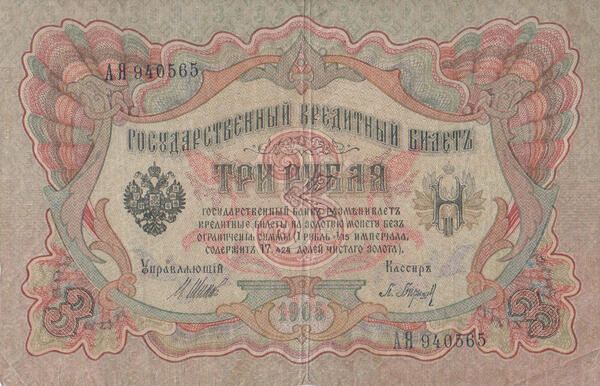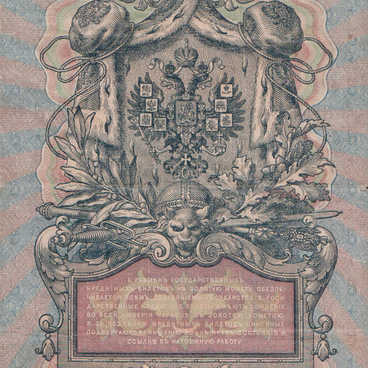Banknotes in denominations of 3 rubles were developed in 1905 and introduced into circulation in 1907. The decision to issue three-ruble banknotes on a mass scale was taken during the difficult period of the Russo-Japanese War. In those years the cruisers Varyag and Koreets were destroyed, there were some disagreements in the Russian headquarters concerning the actions of the army and the command of the land forces. Severe defeats on the Shaho River, at Lyaoyang and Mukden, the siege of Port Arthur by Japanese troops and its subsequent surrender by Anatoly Mikhaylovich Stessel, the death of Admiral Stepan Osipovich Makarov, the serious indirect aid rendered to Japan by Britain, the major defeat of the Russian fleet in the Battle of Tsushima, the generally unfavorable attitude of some governments of major powers towards Russia during the war (especially London and Washington) — all this showed the unpreparedness of the Russian Empire for the war, both in terms of army management and the diplomatic efforts made, which seriously affected the financial situation of the country.
Furthermore, the events after the Bloody Sunday of 9 January 1905 triggered the First Russian Revolution of 1905-1907: mass strikes and industrial action, the December uprising in Moscow and the establishment of the first Soviet in Ivanovo-Voznesensk. The government’s frantic attempts to make minimal concessions had no effect, as they no longer suited anyone. All this further exacerbated the state’s financial problems.
Against the background of failed battles in the Far East and domestic instability, the three-ruble banknotes began to be put into circulation. Like other tsarist paper money, this denomination continued to be issued after the fall of the monarchy.
During the First World War the quality of paper on which money was printed, including the three-ruble banknotes, became lower. Before 1916 thick paper was used for printing, while from 1916 thinner paper became acceptable. Such changes were caused by lack of materials for printing banknotes and too much money was spent on the army because of the war, so the government decided to save money. The money itself depreciated quickly during this period. The banknote on display was printed after the October Revolution by the Soviet government, as evidenced by its serial number АЯ.
Furthermore, the events after the Bloody Sunday of 9 January 1905 triggered the First Russian Revolution of 1905-1907: mass strikes and industrial action, the December uprising in Moscow and the establishment of the first Soviet in Ivanovo-Voznesensk. The government’s frantic attempts to make minimal concessions had no effect, as they no longer suited anyone. All this further exacerbated the state’s financial problems.
Against the background of failed battles in the Far East and domestic instability, the three-ruble banknotes began to be put into circulation. Like other tsarist paper money, this denomination continued to be issued after the fall of the monarchy.
During the First World War the quality of paper on which money was printed, including the three-ruble banknotes, became lower. Before 1916 thick paper was used for printing, while from 1916 thinner paper became acceptable. Such changes were caused by lack of materials for printing banknotes and too much money was spent on the army because of the war, so the government decided to save money. The money itself depreciated quickly during this period. The banknote on display was printed after the October Revolution by the Soviet government, as evidenced by its serial number АЯ.




